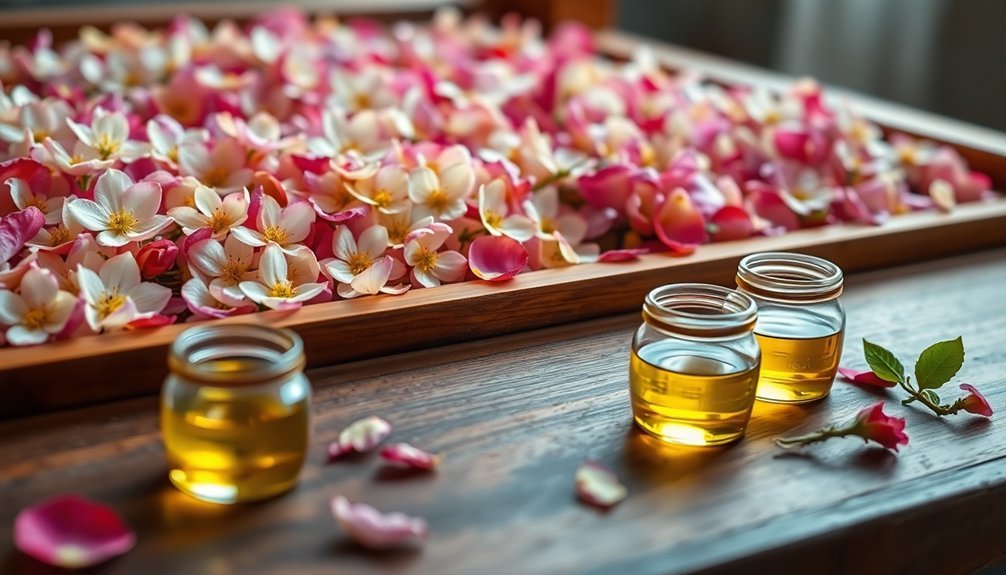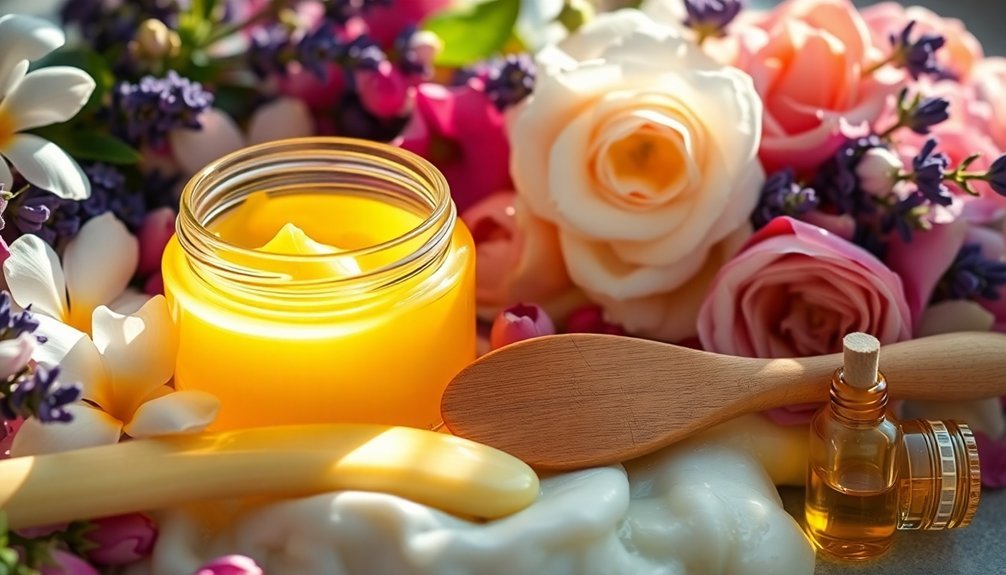To master enfleurage for natural perfumes, you'll need to follow five essential steps. Start by selecting fragrant flowers like jasmine or tuberose, harvested at peak bloom. Next, prepare your workspace with sanitized glass containers and quality fats like coconut oil or shea butter. Set up your station in a temperature-controlled, dust-free area. Choose between cold or hot extraction methods based on your flowers. Finally, transform your pomade into wearable perfume by blending with carriers. The ancient art of enfleurage holds many more secrets to reveal.
Understanding the Ancient Art of Enfleurage

Enfleurage stands as one of perfumery's most elegant extraction methods, dating back to 17th century France.
You'll find two main approaches to this art: cold enfleurage and powder enfleurage, both designed to capture delicate floral essences.
In cold enfleurage, you'll work with a glass tray lined with odorless fat mixed with a small amount of wax.
The process involves laying fresh flowers on the fat surface, allowing them to release their fragrant compounds over several hours.
You'll need to replace these flowers daily until your fat achieves the desired scent intensity.
The historical powder method offers a quicker alternative, using materials like tapioca starch, rice flour, or orris root to absorb flower fragrances.
You'll place flowers in a closed container with your chosen powder, regularly renewing the blooms until reaching your target fragrance strength.
This method is particularly effective with flowers like jasmine and tuberose that continue releasing their fragrance long after being picked.
Selecting Your Flowers and Fats
When creating natural perfumes through enfleurage, your success largely depends on selecting the right combination of flowers and fats.
Choose flowers with potent, lasting fragrances like jasmine, gardenia, tuberose, and roses. You'll want to harvest these in the early morning or evening when their scent is strongest, making certain they're free from moisture and pests.
For your fat base, opt for odorless carriers like refined coconut oil or shea butter. This traditional process dates back to the 18th century France, where it revolutionized fragrance extraction.
You'll need to heat your chosen fat with a small amount of soy or jojoba wax to achieve the right consistency. Pour this mixture into glass trays and let it solidify at room temperature.
Remember to use high-quality, organic fats to guarantee the best results and avoid moisture contamination that could lead to spoilage.
Setting Up Your Enfleurage Station

Setting up a proper enfleurage station requires four essential components: clean equipment, organized workspace, proper storage solutions, and safety measures.
You'll need glass containers, pipettes, and tweezers for handling delicate materials, plus spatulas for working with fats. Following GMP standards, ensure all your equipment is made of SUS 304 stainless steel or comparable food-grade materials.
Keep your workspace between 75F-80F in a dust-free area, and guarantee you have airtight storage containers for preserving your final extracts.
- Use stainless steel or glass containers to prevent contamination
- Maintain proper temperature control in your workspace
- Keep measuring tools handy for precise flower-to-fat ratios
- Wear protective gloves and clothing during the process
- Store finished extracts in a cool, dark place
Remember to sanitize all equipment before use and maintain good ventilation throughout the process.
Always label your batches clearly and follow proper disposal methods for used materials.
Mastering Cold Vs Hot Extraction Methods
With your enfleurage station properly set up, you'll need to choose between two distinct extraction methods: cold and hot enfleurage.
Cold enfleurage requires spreading odorless fat on glass trays, letting it solidify, then layering fresh flowers on top. You'll replace these flowers daily for up to 40 charges until the fat becomes saturated with fragrance.
Hot enfleurage involves heating oils to 140°F and directly macerating the flowers in the warm fat. You'll stir the mixture occasionally, strain the spent flowers, and recharge with fresh ones daily until achieving your desired scent intensity.
While cold enfleurage takes longer, it's gentler on delicate blooms like jasmine and gardenia. Hot enfleurage works better for hardier flowers like roses and orange blossoms, offering a faster extraction process.
Transforming Your Pomade Into Wearable Perfume

Three essential steps transform raw enfleurage pomade into wearable perfume.
Start by blending your enfleurage fat with complementary essential oils and absolutes to create a complex fragrance profile.
Next, dilute the mixture with your preferred carrier oil or alcohol to achieve the right concentration for skin application.
Finally, allow your blend to age, letting the scents meld and mature into a harmonious composition.
- Create solid perfumes by combining your enfleurage fat with additional waxes
- Mix with carrier oils for a luxurious body butter formula
- Blend with alcohol for a traditional liquid perfume
- Store in dark glass bottles to preserve fragrance integrity
- Test different dilution ratios to find your perfect scent strength
For best results, always perform quality control checks on your final product before packaging it in appropriate containers.
Frequently Asked Questions
How Long Can the Finished Enfleurage Pomade Be Stored Before It Spoils?
You can store your enfleurage pomade for up to 1 year if you're keeping it in a cool, dark place with proper sealing. Be sure to check regularly for any signs of rancidity or spoilage.
Can Synthetic Flowers Be Used Instead of Fresh Flowers for Enfleurage?
No, you can't use synthetic flowers for enfleurage since they don't contain natural fragrant oils. They're purely decorative and won't release any aromatic compounds into the fat base during the process.
Does Moonlight or Sunlight Affect the Enfleurage Process Differently?
You'll want to avoid direct sunlight as it can degrade your fragrance molecules and fats. Moonlight won't affect your enfleurage process, so don't worry about lunar exposure during production.
What Happens if Water Accidentally Gets Into the Enfleurage Mixture?
If water gets into your enfleurage mixture, you'll need to act fast. It'll damage fragile flower components, spoil the fat, and cause flower rot. Replace contaminated materials immediately to save your process.
Can Multiple Flower Types Be Combined in a Single Enfleurage Batch?
Yes, you can combine multiple flower types in one enfleurage batch. You'll need to take into account each flower's fragrance strength, blooming season, and compatibility. It's best to select flowers with complementary scent profiles.
In Summary
You've now learned the timeless art of enfleurage, from choosing the right flowers to creating your final perfume. Don't be discouraged if your first attempts aren't perfect – it's all part of the learning process. With practice, you'll develop an intuitive feel for working with different blooms and fats. Keep experimenting, and soon you'll be crafting unique, natural fragrances that rival commercial perfumes.





Leave a Reply